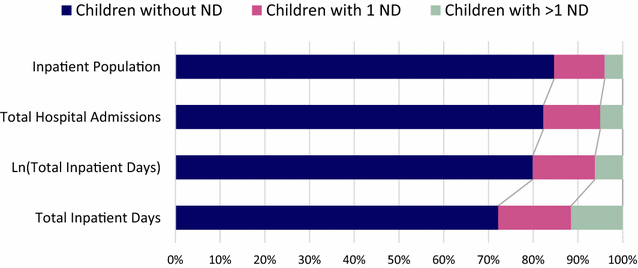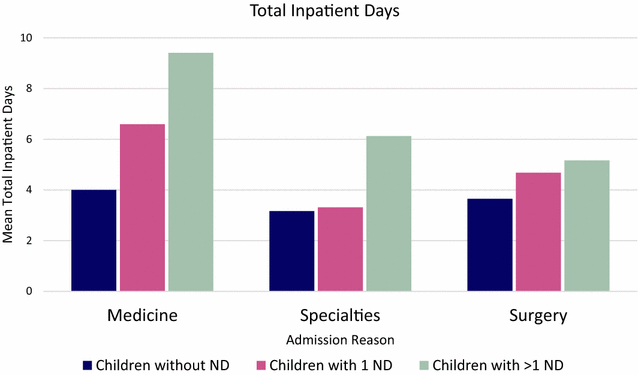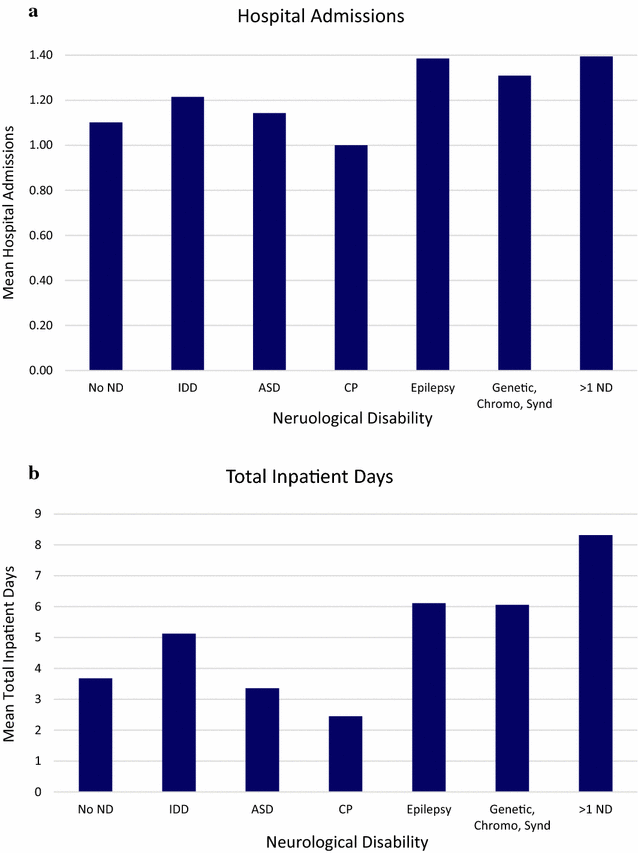Do children with neurological disabilities use more inpatient resources: an observational study
- PMID: 28465710
- PMCID: PMC5408490
- DOI: 10.1186/s12982-017-0059-1
Do children with neurological disabilities use more inpatient resources: an observational study
Abstract
Background: Advances in healthcare have improved the survival of children with neurological disabilities (ND). Studies in the US have shown that children with ND use a substantial proportion of resources in children's hospitals, however, little research has been conducted in the UK. We aimed to test the hypothesis that children with neurological disabilities use more inpatient resources than children without neurological disabilities, and to quantify any significant differences in resource use.
Methods: A retrospective observational study was conducted, looking at the number of hospital admissions, total inpatient days and the reason for admissions for paediatric inpatients from January 1st to March 31st 2015. Inpatients were assigned into one of three groups: children without ND, children with one ND, and children with more than one ND.
Results: The sample population included 942 inpatients (mean age 6y 6mo). Children with at least one ND accounted for 15.3% of the inpatients, 17.7% of total hospital inpatient admission episodes, and 27.8% of the total inpatients days. Neurological disability had a statistically significant effect on total hospital admissions (p < 0.001). Neurological disability also had a statistically significant effect on total inpatient days (p < 0.001). Neurological disability increased the length of inpatient stay across medicine, specialties, and surgery.
Conclusions: Children with ND had more frequent hospital admission episode and longer inpatient stays. We identified a smaller group within this population, with arguably more complex neurological disabilities, children with more than one ND. This group had the highest number of admissions and longest inpatient stays. More frequent hospital admissions and longer inpatient stays may place children with ND at greater risk of the adverse effects of hospitalisations. We recommend further investigations looking at each the effects of the different categories of ND on inpatient resource use, and repeat of this study at a national level and over a longer period of time.
Keywords: Epidemiology; Neurodisability; Paediatrics.
Figures



Similar articles
-
Exploring functional outcomes and allied health staffing levels in an inpatient paediatric rehabilitation unit.Disabil Rehabil. 2019 Feb;41(3):293-298. doi: 10.1080/09638288.2017.1387293. Epub 2017 Oct 10. Disabil Rehabil. 2019. PMID: 28994623
-
Tertiary paediatric hospital admissions in children and young people with cerebral palsy.Child Care Health Dev. 2015 Nov;41(6):928-37. doi: 10.1111/cch.12263. Epub 2015 May 30. Child Care Health Dev. 2015. PMID: 26032706
-
Nationwide trends in inpatient admissions of pulmonary hypertension in the United States from 2000 to 2013.Adv Respir Med. 2017;85(2):77-86. doi: 10.5603/ARM.2017.0014. Adv Respir Med. 2017. PMID: 28440533
-
Resource utilization and charges of patients with and without diagnosed venous thromboembolism during primary hospitalization and after elective inpatient surgery: a retrospective study.J Med Econ. 2018 Jun;21(6):595-602. doi: 10.1080/13696998.2018.1445635. Epub 2018 Mar 1. J Med Econ. 2018. PMID: 29480088
-
Healthcare burden of rare diseases in Hong Kong - adopting ORPHAcodes in ICD-10 based healthcare administrative datasets.Orphanet J Rare Dis. 2018 Aug 28;13(1):147. doi: 10.1186/s13023-018-0892-5. Orphanet J Rare Dis. 2018. PMID: 30153866 Free PMC article. Review.
Cited by
-
Interventions based on early intensive applied behaviour analysis for autistic children: a systematic review and cost-effectiveness analysis.Health Technol Assess. 2020 Jul;24(35):1-306. doi: 10.3310/hta24350. Health Technol Assess. 2020. PMID: 32686642 Free PMC article.
-
The impact of neurological disorders on hospital admissions for children and young people: a routine health data study.Int J Popul Data Sci. 2018 May 17;3(1):421. doi: 10.23889/ijpds.v3i1.421. Int J Popul Data Sci. 2018. PMID: 32935002 Free PMC article.
-
Health and education outcomes from adolescence to adulthood for young people with neurodisability and their peers: protocol for a population-based cohort study using linked hospital and education data from England.BMJ Open. 2025 Mar 18;15(3):e100276. doi: 10.1136/bmjopen-2025-100276. BMJ Open. 2025. PMID: 40107698 Free PMC article.
-
Impact of children with complex chronic conditions on costs in a tertiary referral hospital.Rev Saude Publica. 2022 Oct 17;56:89. doi: 10.11606/s1518-8787.2022056004656. eCollection 2022. Rev Saude Publica. 2022. PMID: 36259914 Free PMC article.
-
Transition from child-centred to adult-oriented healthcare systems for young people with neurodisability: a scoping review protocol.HRB Open Res. 2020 Sep 4;3:61. doi: 10.12688/hrbopenres.13095.1. eCollection 2020. HRB Open Res. 2020. PMID: 33215059 Free PMC article.
References
LinkOut - more resources
Full Text Sources
Other Literature Sources
Medical

